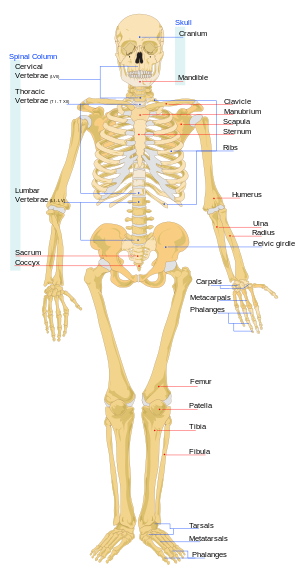Skeletal System
Skeletal System - a body system made up of bones, joints and connective tissues.
Marrow - a soft tissue in the center of some bones.

- Connecting Parts
Cartilage - A strong, flexible, gel like tissue that cushions your joint.
Tendons - Connect Muscles to bones.
Ligaments - Connect Bones to Bones.
Your skeletal system allows you to move.
There are 206 bones in the human body. A newborn has 350 bones.
What does the Skeletal System do?
edit- Supports the body by providing a framework for the body.
- Protects the internal organs. Example: The rib cage protects the heart and lungs.
- Stores minerals needed by various systems in the body. Examples: Calcium and phosphorus.
- Makes blood cells in the bone marrow.
Bones
edit- Cranium - Skull; Keeps the brain protected.
- Clavicle - Collarbone; Keeps the scapula in place/maintains structure for the shoulder and the upper body.
- Sternum - Long, flat, bony plate which protects the heart, lungs and blood vessels.
- Scapula - Shoulder Bone; Connects the lower part of the body to the top of the body/maintains structure for the upper body and shoulder (flat bone).
- Humerus - Arm; The long bone connects the scapula to the lower part of the arm (the ulna and radius)/maintains structure for the upper arm.
- Ulna - The bone that stores minerals and makes blood cells in the marrow/allows movement through the elbow and the wrist.
- Radius - Paired up with the Ulna and accomadates with the rotation of the forearm. The ulna also performs this function. Also maintains structure for lower arm.
- Ribs - The ribcage serves to protect the heart and lungs, supports the torso and performs respiration (flat bone).
- Vertebrae - Spine/Backbone; 33 ring-shaped bones stacked on top of each other to make the spinal cord/protects the spinal cord and provides support for the upper body (types of vertebrae are irregular).
- Pelvis - Hip; Protects the organs of the pelvic cavity and supports the hips, thighs, and abdomen (legs).
- Carpals - Helps with the movement of the wrist.
- Femur - Thigh; Supports the weight of the body and accommodates in leg motion/Longest and heaviest bone.
- Patella - Kneecap; Covers/protects the anterior articular surface of the knee joint.
- Fibula - Stables the ankles and helps out with the muscles of the lower leg.
- Tibia - Biggest bone in the lower leg; Shin bone which helps with the distribution of weight across the knee to the ankle/supports lower leg.
- Tarsals - Helps with the distribution of force from the tibia to the heel bone.
- Phalanges - Bones in the fingers and toes.
Joints
editA joint is the point where two bones meet. There are three types of joints: immobile, slightly mobile, and mobile joints.
Immobile, Slightly Immobile, and Mobile Joints
editImmobile
edit- Immobile joints are joints that don't move after an infant develops toward maturity, and the separate bones fuse together.
Examples: Cranium (skull): the fused bones covered by your scalp; coccyx (tailbone): the fused bones at the base of your spine.
Slightly Immobile
edit- Slightly Immobile joints are joints that permit slight movement.
Example: Between the vertebrae of the back. These joints are cushioned by a spongy disk that can break open and leak the shock-absorbing gel inside. Such a herniated, ruptured, or "slipped" disk can result in inflammation of surrounding tissues and varying levels of pain.
Mobile
edit- Mobile joints are joints that permit a wide range of movement.
Examples: Knees, shoulders, fingers. Over time, if mobile joints suffer wear or injury, the lubricating fluid between the bones becomes prone to the periodic accumulation of tiny gas bubbles. The popping of these bubbles when the joint is moved produces an audible "crack" or "creak". A great example of this is the annoying sound of "cracking your knuckles". Once the bubbles pop, it takes time for more bubbles to accumulate, which is why you cannot continuously crack your knuckles, and why many people hear their joints crack when they get out of bed or rise from a prolonged sitting position.
Connective Tissues
editConnective tissues are strong, flexible tissues that connect, secure, and cushion joints. There are three types: ligaments, tendons, and cartilage. Damage to or loss of connective tissue has a negative impact on the working of the joint, as well as causing varying levels of pain. Some injuries may require surgery to enable healing; for example, a third-degree sprain of the anterior cruciate ligament, better known as a "torn ACL", is a common knee injury often suffered by professional athletes and requires surgical treatment. Loss of connective tissue may also require surgical treatment or replacement.
- Ligament: Connects the bones of a joint.
- Tendon: Secures muscle to bone.
- Cartilage: Cushions the bones of the joint.
Sprains/Diseases in relation with the Skeletal System
editFractures - A break in a bone caused by an injury.
Dislocations - When a bone is pushed out of its joint.
Sprain - Stretching or twisting of ligaments. (Full definition: Ligaments are short parts of tough, flexible connective tissues that connects two bones, or cartilages, or holds together a joint)
Overuse - Injuries - occurs over time.
Scoliosis - A disorder where the spine curves in a "C" or "S" like curve/shape.
Osteoporosis - A disease where the bones are brittle.
Taking care of your skeletal system
editA. Good Dairy products contain calcium, phosphorus, magnesium, and Vitamin D. These vitamins help with the strengthening of bones.
B. Regular Exercise: Increases Bone Mass.
C. Good Posture helps keep the spine healthy and in balance.
D. Take time to heal: Wait for it to be completely healed before returning to physical activity.
E. Use protective gear when doing physical activities, such as riding your bicycle.
Sources
edit- Notes